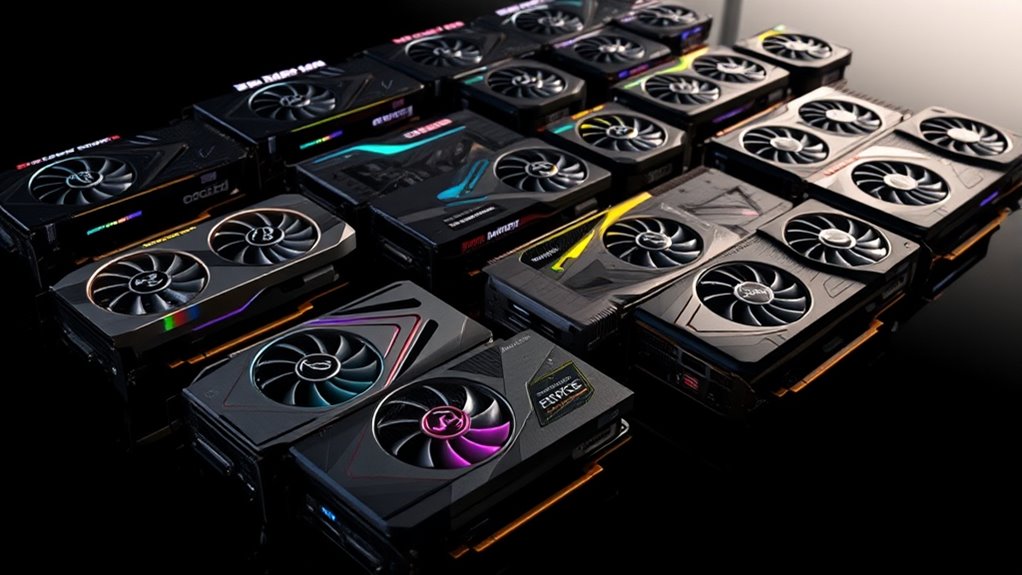If you’re after the best premium graphics cards for an unbeatable gaming setup, I recommend focusing on options like the MSI GeForce RTX 3060, GIGABYTE RTX 3060 OC, and the high-performance ASUS RTX 5080. These cards deliver top-tier performance, excellent cooling, and future-proof features like DLSS 4 and PCIe 5.0 support. Whether you’re gaming at 4K or working creatively, these choices won’t disappoint. Keep exploring more to find the perfect fit for your rig.
Key Takeaways
- Highlights top-tier GPUs like NVIDIA RTX 3060, 5070 Ti, and AMD RX 9060 XT for demanding gaming and creative tasks.
- Details advanced cooling systems such as WINDFORCE, vapor chambers, and dual dissipation for optimal thermal management.
- Emphasizes compatibility, build quality, and size considerations for seamless integration into high-performance gaming rigs.
- Showcases performance benchmarks in high-resolution, AAA titles, and VR environments for unmatched gaming experience.
- Includes price ranges, value propositions, and additional features to help select the best premium graphics card for various budgets.
MSI GeForce RTX 3060 12GB Graphics Card
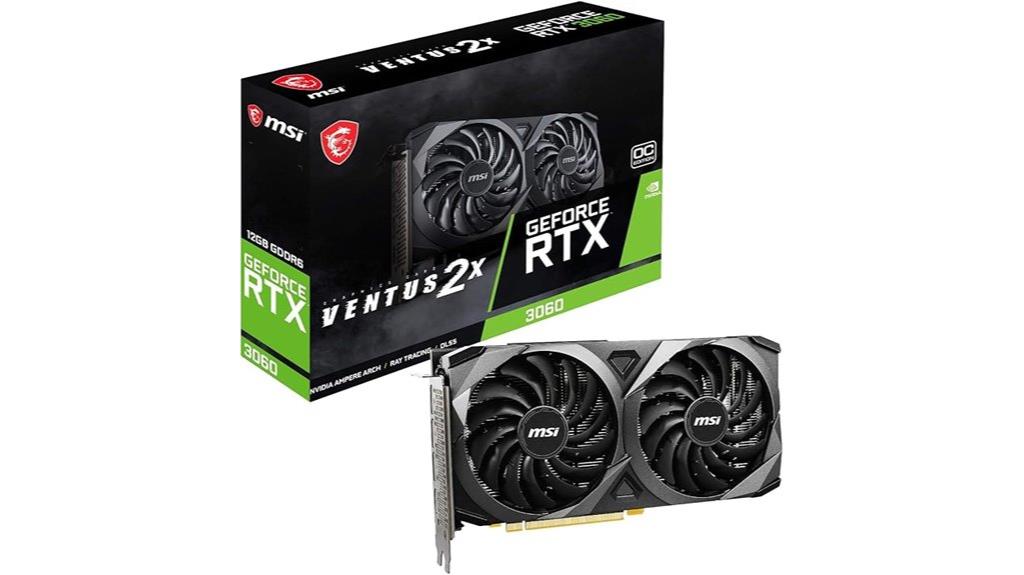
If you’re looking for a powerful graphics card that delivers exceptional gaming and creative performance, the MSI Gaming GeForce RTX 3060 12GB is an excellent choice. It features NVIDIA’s RTX 3060 GPU with 12GB of GDDR6 memory, ensuring smooth gameplay and fast rendering. With a GPU clock of 1710 MHz and memory speed of 1807 MHz, it handles demanding tasks effortlessly. The card offers multiple display outputs—three DisplayPorts and one HDMI 2.1—supporting resolutions up to 7680 x 4320. Its Torx Twin Fan cooling system and Ampere architecture make it reliable for overclocking and extended use.
Best For: gamers and creative professionals seeking high-performance graphics rendering and smooth multitasking capabilities.
Pros:
- Excellent gaming performance with NVIDIA’s RTX 3060 GPU and 12GB GDDR6 memory
- Supports high-resolution displays up to 7680 x 4320 for immersive visuals
- Reliable cooling system with Torx Twin Fan and robust Ampere architecture
Cons:
- May be overkill for casual or less demanding gaming needs
- Limited to PCIe 4 interface, requiring compatible motherboards
- Potentially higher power consumption due to overclocked performance
GIGABYTE GeForce RTX 3060 Gaming OC 12G Graphics Card
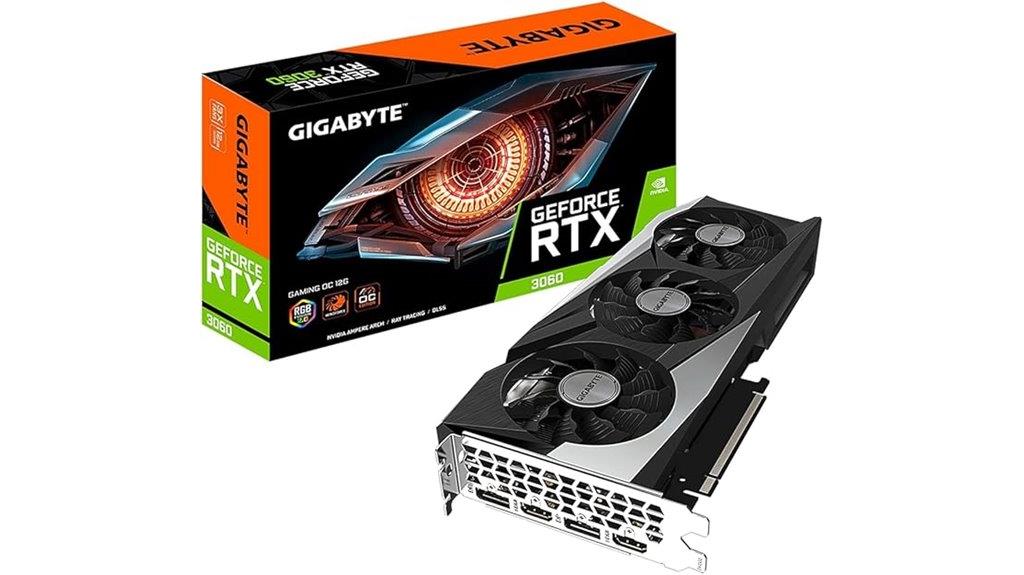
The GIGABYTE GeForce RTX 3060 Gaming OC 12G is an excellent choice for gamers and content creators seeking high performance without breaking the bank. Powered by NVIDIA’s Ampere architecture, it features 12GB GDDR6 memory and a core clock of 1837 MHz, supporting up to 8K resolution. Its WINDFORCE 3X cooling system keeps temperatures below 75°C, ensuring quiet operation. The card handles modern games at high FPS, often exceeding 120 FPS at 1080p, and performs well in creative and AI tasks. Easy to install, it’s compatible with current setups, offering a great balance of power, efficiency, and value for budget-conscious users.
Best For: budget-conscious gamers and content creators seeking reliable high-performance graphics without overspending.
Pros:
- Excellent price-to-performance ratio with strong gaming and creative performance
- Quiet operation and effective cooling system maintaining temperatures below 75°C
- Supports high resolutions up to 8K, ideal for future-proofing and multi-display setups
Cons:
- May experience limited performance with DX12 API in some titles
- Size and cooling system might require larger cases for proper installation
- Power requirements necessitate a compatible PSU with 6+2 or 8-pin connectors, which could be a challenge for older builds
GIGABYTE GeForce RTX 5070 Ti Gaming OC 16G Graphics Card
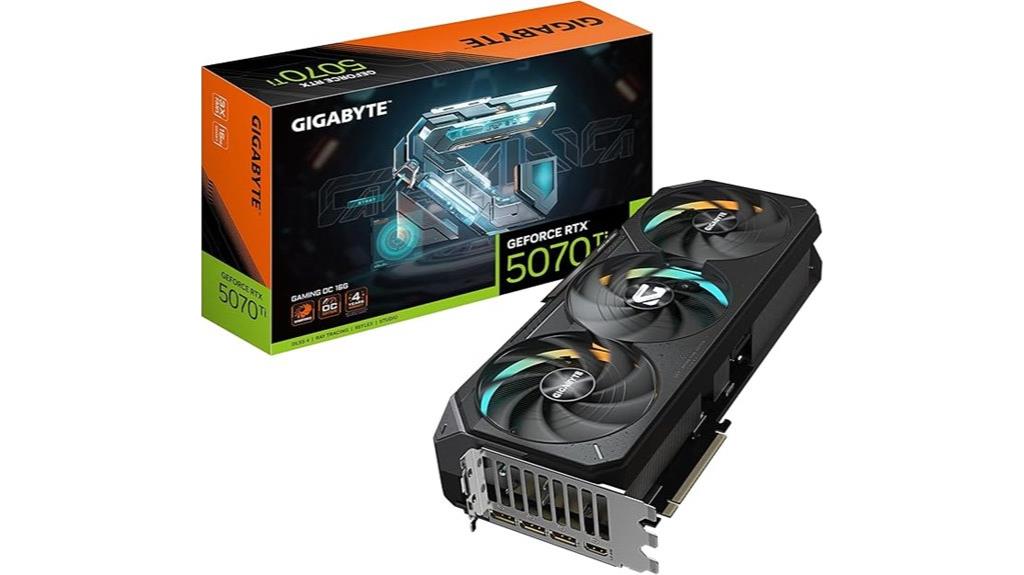
For gamers and creative professionals seeking top-tier performance, the GIGABYTE GeForce RTX 5070 Ti Gaming OC 16G stands out as a premier choice. Powered by NVIDIA’s Blackwell architecture, it features DLSS 4, enhanced RT and Tensor Cores, and 16GB of GDDR7 memory, delivering stunning visuals and high frame rates. The PCIe 5.0 interface and WINDFORCE cooling system ensure efficient performance and thermal management. It handles demanding games like Cyberpunk 2077 and F1 25 at 1440p and 4K, with minimal FPS drops and excellent ray tracing. Its build quality is solid, cooling is effective, and user reviews highlight stability, quiet operation, and great value for high-end gaming and creative work.
Best For: gamers and creative professionals seeking high-performance graphics rendering at 1440p and 4K resolutions with excellent ray tracing and AI features.
Pros:
- Outstanding performance in demanding AAA titles with minimal FPS drops
- Effective cooling system maintains low temperatures and quiet operation
- Supports high-refresh-rate multi-monitor setups and creative workloads
Cons:
- Large size may require a spacious case for installation
- Minor packaging or recognition issues upon arrival reported by some users
- Premium features and build quality come at a higher price point compared to mid-range options
ASUS TUF Gaming GeForce RTX 5080 16GB Graphics Card
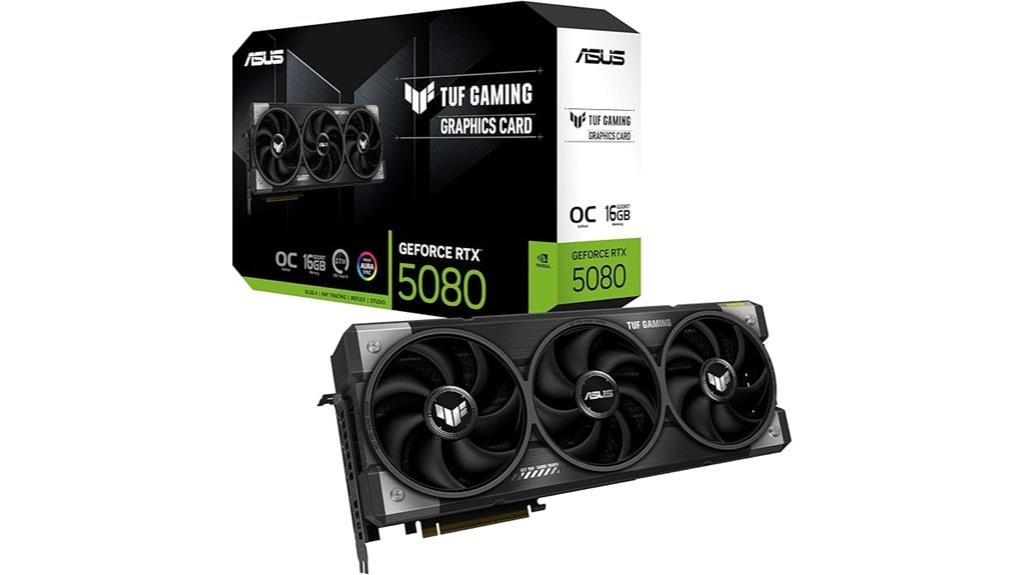
Driven by NVIDIA’s Blackwell architecture and DLSS 4 technology, the ASUS TUF Gaming GeForce RTX 5080 16GB stands out as an exceptional choice for gamers, creators, and AI professionals demanding top-tier performance. Built with military-grade components and a protective PCB coating, it offers durability and reliability. Supporting PCIe 5.0, HDMI 2.1, and DP 2.1, it’s optimized for high airflow with vapor chamber cooling and axial-tech fans. Excelling in 4K gaming, creative workflows, and AI tasks, it delivers smooth performance and thermal stability. Its premium all-metal design, low noise, and high performance make it a standout in premium graphics cards.
Best For: gamers, creative professionals, and AI researchers seeking high-performance graphics with reliable durability and advanced cooling.
Pros:
- Exceptional performance in 4K gaming, creative workflows, and AI tasks with NVIDIA Blackwell architecture and DLSS 4.
- Built with military-grade components and a protective PCB coating for enhanced durability and long lifespan.
- Premium all-metal design with effective vapor chamber cooling and axial-tech fans for low temperatures and quiet operation.
Cons:
- Larger and heavier than standard cards, requiring sufficient case space and proper airflow setup.
- Slightly higher price point compared to previous generation GPUs, reflecting its premium features.
- Some users have reported minor manufacturing issues like bent fins, though these do not affect performance.
XFX Radeon RX 580 GTS XXX Edition Graphics Card (RX-580P8DFD6)
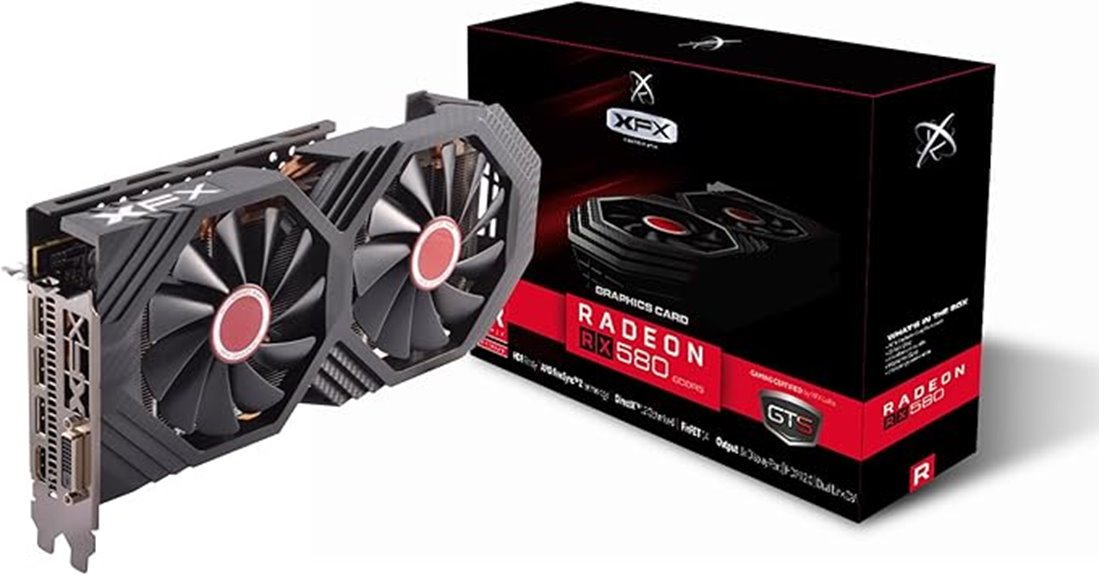
If you’re seeking a reliable high-performance graphics card that delivers immersive gaming and multimedia experiences, the XFX Radeon RX 580 GTS XXX Edition stands out with its factory overclocked speeds and ample 8GB GDDR5 memory. It features a true clock of 1366MHz and boosts up to 1386MHz, ensuring smooth gameplay. Built on Polaris architecture with 4th gen GCN cores, it supports VR via AMD LiquidVR for low-latency virtual reality. With multiple output options—DisplayPort, HDMI, and DVI—plus XFX’s double dissipation cooling technology, it offers efficient thermal management. This card is ideal for high-performance gaming and multimedia tasks, combining power and reliability seamlessly.
Best For: gamers and multimedia enthusiasts seeking a high-performance, VR-ready graphics card with reliable overclocking and ample memory for immersive experiences.
Pros:
- Factory overclocked for enhanced gaming performance
- 8GB GDDR5 memory supports high-resolution and multitasking
- Efficient cooling with XFX double dissipation technology
Cons:
- Requires a minimum power supply of 500W, which may necessitate upgrades
- Limited to AMD-based systems for optimal compatibility
- Slightly larger size may require adequate case space
Sapphire Pulse AMD Radeon RX 9060 XT Graphics Card with 16GB GDDR6
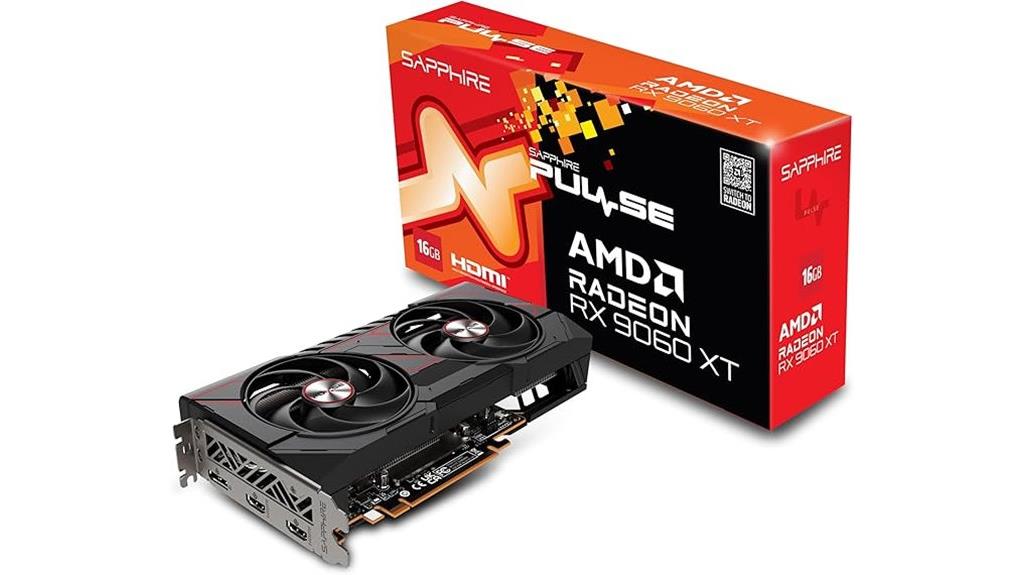
The Sapphire Pulse AMD Radeon RX 9060 XT Graphics Card stands out as an excellent choice for gamers and creators seeking high performance without breaking the bank. With 16GB of GDDR6 memory and support for AMD RDNA 4 architecture, it handles demanding games at 1440p and 4K with ease. It outperforms many competitors, delivering high frame rates in titles like Cyberpunk 2077 and Minecraft. Its compact, lightweight design, quiet operation, and efficient cooling make it ideal for versatile builds. Priced around $359–$400, it offers incredible value, combining power, future-proofing, and reliability, making it a top pick for a premium gaming setup.
Best For: budget-conscious gamers and creators seeking high-performance graphics without sacrificing affordability or size.
Pros:
- Excellent gaming performance at 1440p and 4K resolutions with high frame rates
- Quiet operation and efficient cooling for a reliable, low-noise experience
- Great value with a competitive price point around $359–$400, offering high-end features on a budget
Cons:
- Slightly limited RGB customization options, as it has no LED lighting
- May require system upgrades for optimal PCIe 5.0 support in older systems
- Thermal performance, while good, could improve with additional aftermarket cooling solutions for overclocking
GIGABYTE 2GB RAM DDR3 SDRAM Video Graphics Cards GV-N710D3-2GL REV2.0
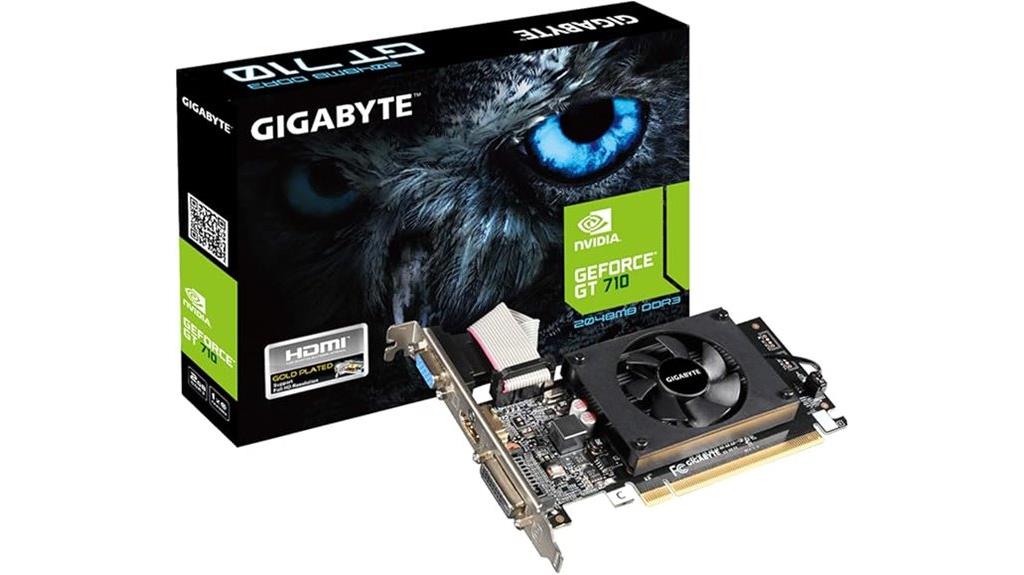
For users seeking an affordable and compact upgrade for basic multimedia tasks and multi-monitor setups, the GIGABYTE GV-N710D3-2GL REV2.0 stands out as a reliable choice. This low-profile NVIDIA GeForce GT 710 card features 2GB DDR3 SDRAM, a core clock of 954 MHz, and supports resolutions up to 4096×2160 pixels. It offers multiple outputs—DVI-D, D-Sub, HDMI—making it easy to connect several displays. Designed for straightforward installation, it’s compatible with Windows 7 and 10. While not suited for gaming, it provides stable, lag-free performance for everyday tasks, multi-monitor use, and multimedia, all at a competitive price.
Best For: users seeking an affordable, compact graphics solution for basic multimedia tasks and multi-monitor setups without gaming or high-end graphics needs.
Pros:
- Easy to install and compatible with Windows 7 and 10
- Supports multiple outputs (DVI-D, D-Sub, HDMI) for multi-monitor setups
- Provides stable, lag-free performance for everyday use and multimedia tasks
Cons:
- GDDR3 memory limits performance in web browsing and multimedia applications
- Not suitable for gaming or graphics-intensive workloads
- PCIe x16 slot operates at PCIe 2.0 x8 bandwidth, which may impact performance
PowerColor Hellhound Spectral White AMD Radeon RX 9060 XT 16GB GDDR6 Graphics Card
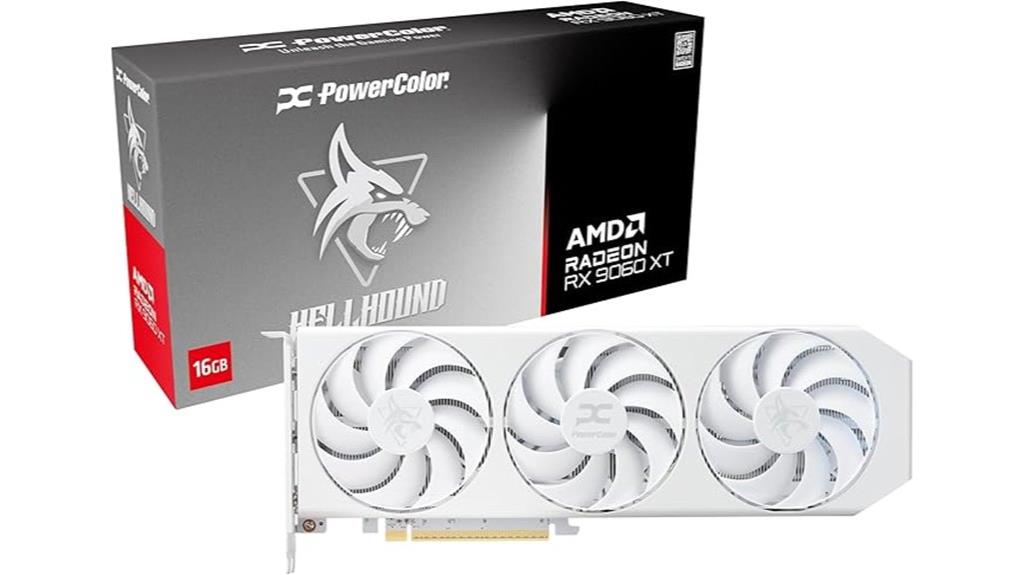
The PowerColor Hellhound Spectral White AMD Radeon RX 9060 XT 16GB GDDR6 Graphics Card stands out for advanced gamers and professionals who demand high-resolution performance and efficient thermal management. It supports up to 8K resolution with a 20 GHz memory speed and 16 GB VRAM, ensuring smooth gameplay at high settings. Benchmarks show it surpasses previous models like the RX 7900 GRE by 19-30%, delivering high frame rates in demanding titles. Its quiet operation, effective heat dissipation, and factory overclocking make it ideal for midsize cases. Priced around $750, it offers excellent value for those seeking premium performance, especially in 4K and professional multitasking environments.
Best For: gamers and professionals seeking high-resolution, high-performance graphics with efficient thermal management in mid-sized cases.
Pros:
- Excellent performance boost over previous models, delivering up to 30% improvements in demanding titles
- Quiet operation with effective thermal management, suitable for gaming in midsize cases
- Supports high resolutions up to 8K, making it ideal for professional work and high-end gaming
Cons:
- High price point around $750 may be a barrier for some users
- Limited RGB lighting design, focusing more on performance than aesthetics
- Reduced ray-tracing performance in some setups, especially in eGPU configurations due to Thunderbolt bottlenecking
RX 580 8GB Graphics Card for Gaming PCs
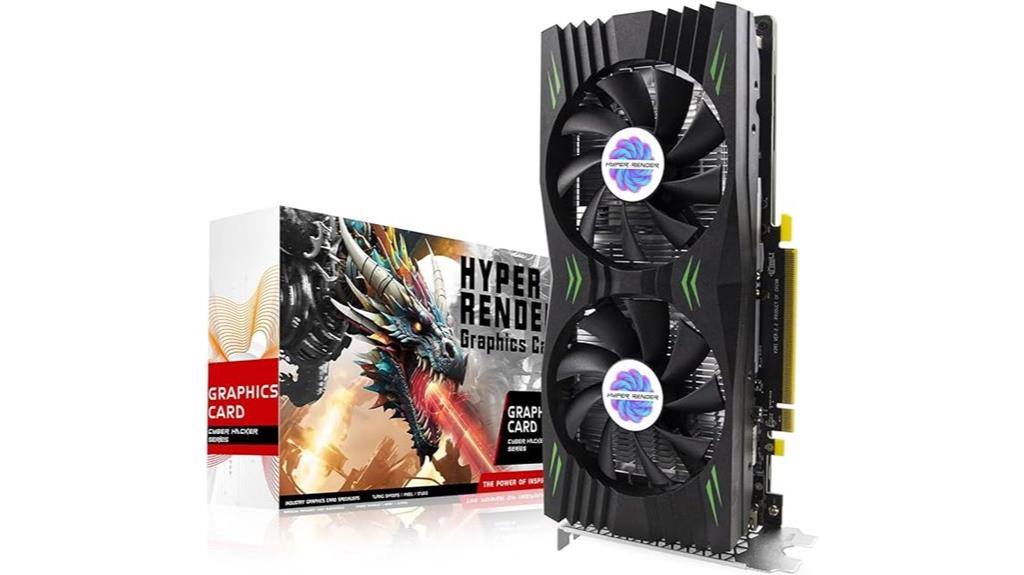
If you’re building a budget-friendly gaming PC that still delivers solid performance, the RX 580 8GB graphics card is an excellent choice. Built on 14nm architecture with 2048 stream processors and 8GB GDDR5 memory at 1750 MHz, it handles latest AAA titles smoothly and with vivid visuals. It supports up to two displays via HDMI and DisplayPorts, perfect for multitasking or multi-monitor setups. Its HyperRender cooling system keeps temperatures in check while reducing noise during idle or low loads. While some users report occasional crashes or compatibility issues, overall, it offers great value for beginner gamers, older systems, or those on a tight budget.
Best For: budget-conscious gamers and users with older systems seeking reliable, high-value gaming performance.
Pros:
- Handles latest AAA titles smoothly with vivid visuals
- Supports multi-monitor setups via HDMI and DisplayPort
- Effective cooling system reduces noise and maintains optimal temperatures
Cons:
- Occasional crashes and display port malfunctions reported by some users
- Large footprint may not fit in all PC cases
- Possible compatibility issues with certain motherboards or cases
Radeon RX 580 8GB Graphics Card for Gaming and Office
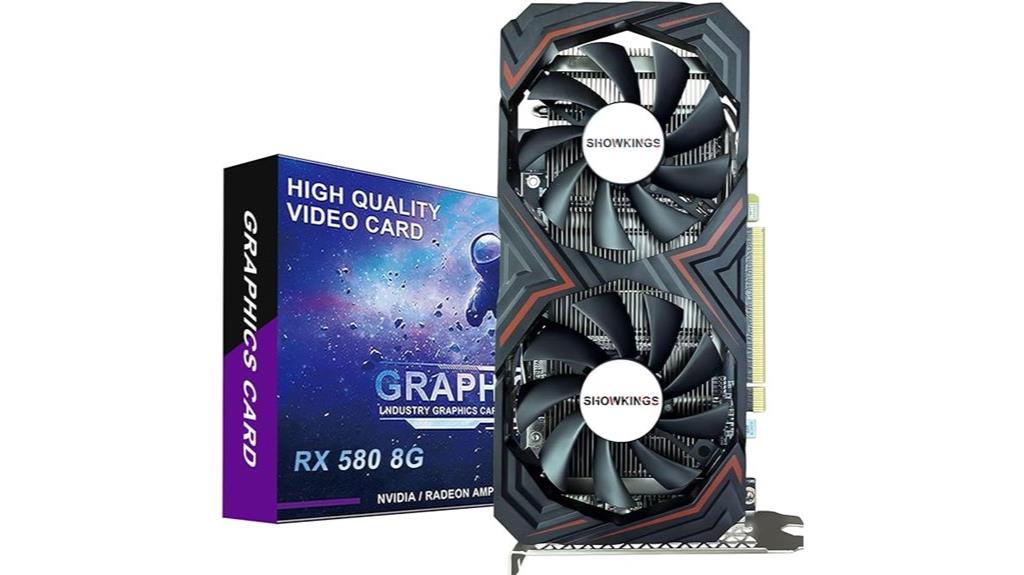
The Radeon RX 580 8GB Graphics Card stands out as an excellent choice for gamers and office users seeking strong performance at an affordable price. Built on a 14 nm process, it offers 2048 Stream Processors, 8GB GDDR5 memory, and a 1750 MHz core clock, supporting up to 4K resolution. Its multi-monitor support with DisplayPort, HDMI, and DVI makes it versatile for gaming, multimedia, and professional workflows. The cooling system with dual fans and composite heat pipes guarantees quiet, efficient operation. Whether you’re gaming or handling demanding office tasks, this card delivers reliable, high-quality visuals and smooth performance across various applications.
Best For: gamers and office users seeking reliable, high-quality graphics performance for gaming, multimedia, and professional tasks at an affordable price.
Pros:
- Supports up to 4K resolution for crisp visuals
- Multi-monitor support with DisplayPort, HDMI, and DVI ports
- Quiet dual-fan cooling system ensures efficient thermal management
Cons:
- Dimensions may require checking case compatibility
- Requires uninstalling previous drivers before installation
- Limited to PCI-Express 3.0 x16 interface
RX 5700 XT 8GB Graphics Card with Dual Cooling Fans
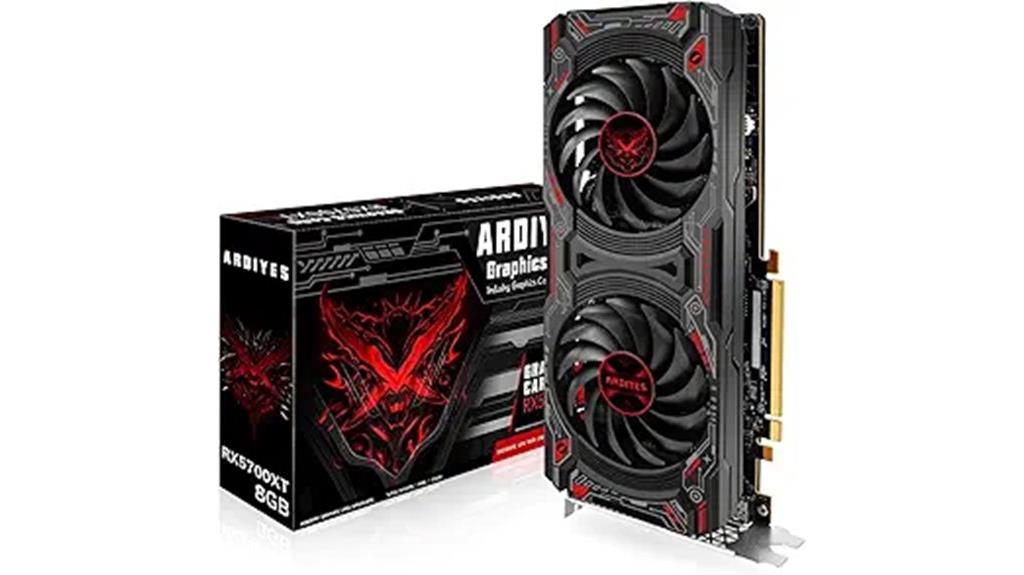
For gamers seeking a high-performance graphics card that balances power and quiet operation, the RX 5700 XT 8GB with dual cooling fans stands out. It features GDDR6 memory, a 256-bit interface, and supports DirectX 12 and PCIe 4.0, making it ideal for 1440p gaming. Built on a 7nm architecture, it handles AAA titles smoothly, boosting FPS from 45 to 65-80. The dual fans with intelligent control keep the card cool while remaining quiet, even during intense sessions. Plus, software enhancements improve visuals and streaming. Overall, it’s a sleek, efficient upgrade that offers excellent performance for demanding games and multimedia tasks.
Best For: gamers seeking a high-performance, quiet graphics card optimized for 1440p gaming and demanding multimedia tasks.
Pros:
- Excellent gaming performance with significant FPS boosts in AAA titles
- Quiet dual cooling fans with intelligent control and idle fan-stop feature
- Supports modern technologies like GDDR6, PCIe 4.0, and DirectX 12, ensuring future-proofing
Cons:
- Requires two 8-pin PCIe power cables, which may add cable clutter
- Slightly higher price point compared to older or less advanced GPUs
- Packaging includes a GPU support post, which may be unnecessary for some builds
QTHREE GeForce GT 730 4GB DDR3 Graphics Card
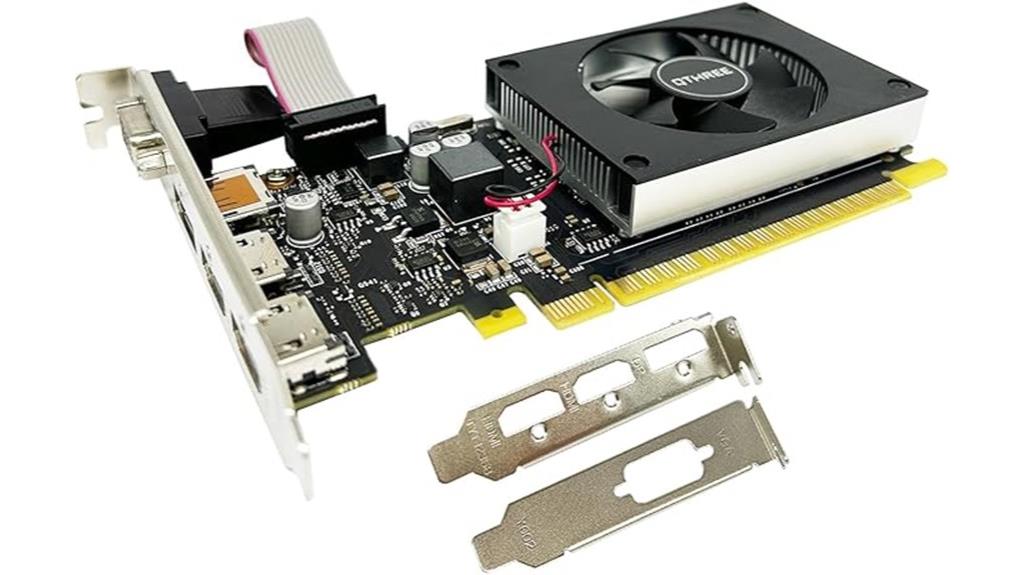
The QTHREE GeForce GT 730 4GB DDR3 Graphics Card is an excellent choice for users who need reliable, budget-friendly display performance for basic tasks. It offers smooth HD video playback, supports multiple monitors, and features a compact low-profile design that’s easy to install in small cases. With a 1000 MHz memory clock and 4GB DDR3 memory, it handles everyday office work and light multimedia effortlessly. Its plug-and-play setup means no fuss, and it consumes just 30W, requiring no external power. Overall, this card provides a simple, efficient solution for upgrading systems meant for basic use without breaking the bank.
Best For: users seeking an affordable, reliable graphics solution for basic office tasks, light multimedia, and multi-monitor setups in small or compact cases.
Pros:
- Supports up to four monitors for increased productivity
- Low power consumption at only 30W, no external power required
- Easy to install with plug-and-play setup and compatible with small form factor cases
Cons:
- Limited performance suitable only for basic tasks and light multimedia
- DDR3 memory may not handle more demanding applications or gaming
- Lacks high-end features or support for newer, more resource-intensive software
Radeon Rx 550 4GB Graphics Card
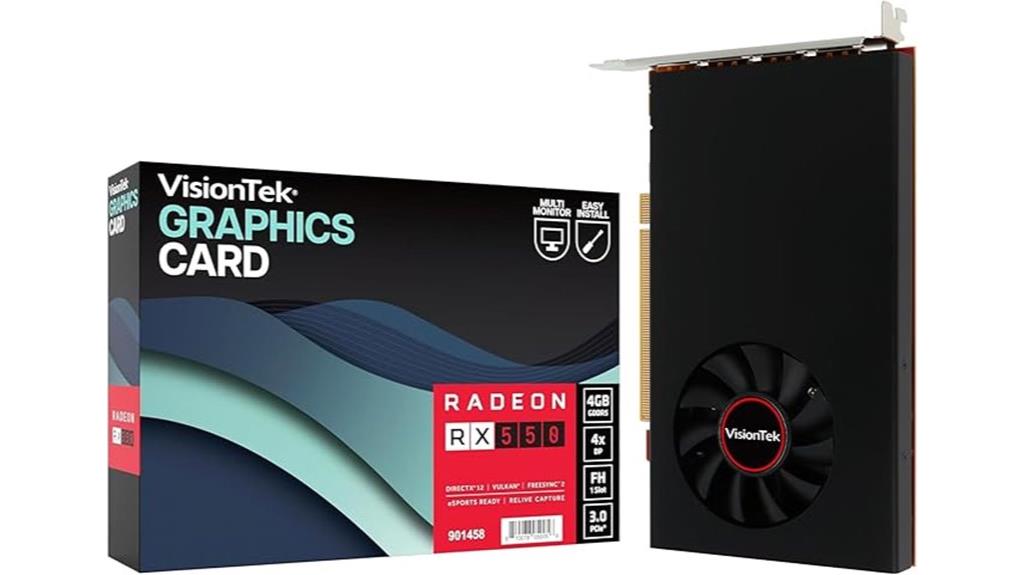
If you’re building a multi-monitor setup or need a reliable graphics card for video editing, the Radeon Rx 550 4GB stands out as a solid choice. It supports 4K resolution and can connect up to four monitors at 60Hz, making it ideal for productivity and immersive gaming. With x4 HDMI outputs, Radeon FreeSync 2 technology, and a PCI Express 3.0 interface, it offers smooth, tear-free visuals. The card is bus-powered, so no extra power connectors are needed. Equipped with 4GB GDDR5 memory and AMD’s RDNA architecture, it delivers efficient performance in gaming and graphic-heavy tasks, all in a compact, easy-to-install package.
Best For: users seeking a budget-friendly, multi-monitor setup or video editing solution with reliable 4K support.
Pros:
- Supports up to four 4K monitors at 60Hz for enhanced productivity and immersive experiences
- Easy to install with plug-and-play setup and no extra power connectors required
- Compatible with both Windows and Linux, offering versatile usability
Cons:
- Potential port detection issues or hardware glitches reported by some users
- Limited to 4GB GDDR5 memory, which may not suffice for high-end gaming or intensive tasks
- Some units may experience hardware failures or missing accessories upon delivery
PNY NVIDIA GeForce RTX™ 5050 Graphics Card (8GB GDDR6, PCIe 5.0)
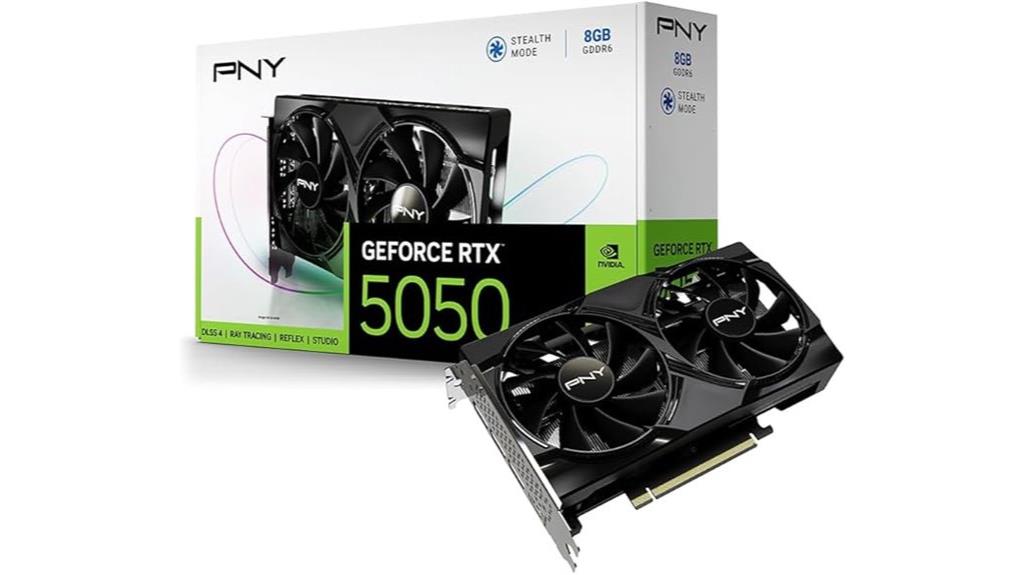
Looking for a compact yet powerful graphics card that delivers top-tier performance in small builds? The PNY NVIDIA GeForce RTX™ 5050 is perfect for compact gaming rigs, featuring an 8GB GDDR6 memory and PCIe 5.0 support. Its NVIDIA Blackwell architecture with 4th-gen Ray Tracing and 5th-gen Tensor Cores offers enhanced AI, realistic lighting, and faster rendering. The dual-fan design fits into 2-slot setups, making it ideal for small form factors. With DLSS 4, ray tracing, and Reflex technologies, it provides smooth gameplay, stunning visuals, and quick response times. This card balances power and size seamlessly, elevating your gaming and creative experience.
Best For: gamers and content creators seeking a compact, high-performance graphics card with advanced AI and ray tracing capabilities for small form factor builds.
Pros:
- Compact 2-slot design ideal for small builds and SFF systems
- Supports PCIe 5.0 for faster data transfer and future-proofing
- Features DLSS 4, ray tracing, and Reflex technologies for enhanced visual quality and responsiveness
Cons:
- Limited to 8GB GDDR6 memory, which may be less suitable for ultra-high-resolution or very demanding workloads
- First available in September 2025, so availability and pricing may vary initially
- Slightly heavier at 1.7 pounds, which could be a consideration for very tight or delicate setups
Factors to Consider When Choosing Premium Graphics Cards for Gaming Rigs
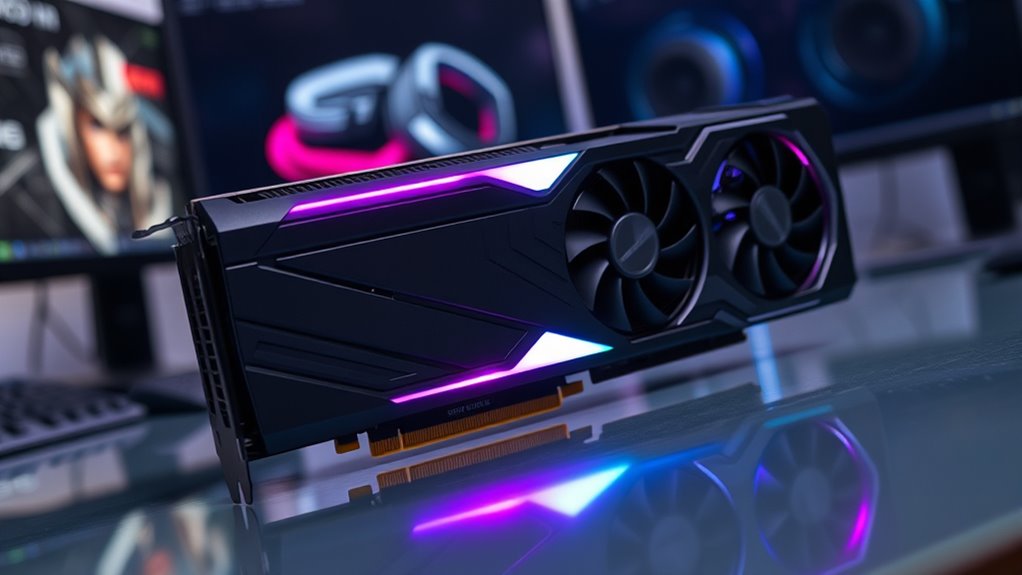
When selecting a premium graphics card for gaming, I focus on performance benchmarks and how well it handles the resolutions I play at. I also consider cooling solutions and power supply requirements to guarantee my system stays stable and efficient. Finally, I check the card’s size and compatibility with my case to make sure it fits perfectly.
Performance Benchmarks
Performance benchmarks are essential tools for evaluating the true capabilities of premium graphics cards. They often include frame rates at 1080p, 1440p, and 4K resolutions, giving a clear picture of real-world gaming performance. Synthetic tests like 3DMark, Unigine Heaven, and Time Spy provide standardized scores that make comparing models straightforward. Additionally, real-world gaming tests measure average FPS, minimum FPS, and frame time consistency, which are critical for smooth gameplay. These benchmarks also reveal how well a GPU handles advanced features like ray tracing and DLSS without sacrificing performance. High and consistent benchmark results usually indicate a GPU’s ability to run demanding titles smoothly and ensure future-proofing for upcoming game releases. It’s a crucial step in selecting a top-tier gaming card.
Resolution Compatibility
Choosing the right graphics card means more than just checking its performance benchmarks; you also need to guarantee it can handle your monitor’s resolution. For ideal visual fidelity, assure the card supports your monitor’s maximum resolution, whether that’s 4K or 8K. Check that its display outputs include HDMI 2.1, DisplayPort 1.4, or higher, to handle high-resolution signals effectively. Verify the maximum supported resolution listed in the specs to confirm compatibility with your setup. If you plan on using multiple monitors, confirm the card can support high-resolution configurations across all screens without performance dips. Additionally, features like G-SYNC or FreeSync can help prevent screen tearing at high resolutions, providing smoother gameplay. Ultimately, resolution compatibility guarantees you get the best visual experience without bottlenecks.
Cooling Solutions
Effective cooling solutions are crucial for maintaining ideal GPU temperatures during intense gaming sessions. Premium cards often feature vapor chambers, dual or triple fan setups, and large heatsinks, which help dissipate heat efficiently. Advanced cooling systems can lower GPU temps by 10-20°C compared to standard designs, preventing thermal throttling and extending component lifespan. Many cards include RGB lighting with customizable fan curves, allowing users to balance airflow, noise levels, and cooling performance. Open-air architectures excel in well-ventilated cases, while closed-loop liquid cooling offers superior thermal management in compact builds. Proper airflow within the case—strategic placement of intake and exhaust fans—further enhances cooling efficiency. Choosing the right cooling solution ensures your GPU stays cool, quiet, and performs at its peak during demanding gaming sessions.
Power Supply Needs
When upgrading to a premium graphics card, it’s essential to guarantee your power supply unit (PSU) can handle the increased demands. High-end GPUs usually require at least 650W to 750W capacity to ensure stable performance under load. Many premium models also need dedicated 8-pin or 8+6-pin PCIe power connectors, so your PSU must support these connections for proper power delivery. Insufficient wattage or incompatible connectors can cause instability, crashes, or system failures, especially during intense gaming or rendering. I recommend a PSU with 80 PLUS Gold or Platinum certification to ensure efficiency and reduce heat. Always verify your PSU has enough headroom for peak power demands, preventing bottlenecks and ensuring your system runs smoothly at all times.
Size and Fit
Upgrading to a premium graphics card requires more than just evaluating its performance; fitting it into your gaming rig is equally important. First, check the card’s dimensions—length, width, and height—to ensure it fits comfortably inside your case without obstructing other components. Measure available space, including clearance for airflow and installation tools, especially for larger, high-performance GPUs. Also, verify your motherboard supports the card’s slot requirements, typically PCIe x16. Don’t forget to take into account the cooling solution; larger heatsinks and fans need adequate room to prevent thermal issues. Finally, examine the power connectors and wattage demands, making sure your power supply can handle the card’s size and energy needs. Proper sizing guarantees smooth installation and ideal performance.
Feature Set
Choosing the right premium graphics card hinges on its feature set, which directly impacts gaming performance and future-proofing. I look for the latest GPU architectures, like NVIDIA’s Ada Lovelace or AMD’s RDNA 3/4, ensuring maximum efficiency and power. High VRAM, typically 12GB or more, is essential for 4K gaming and demanding applications. Support for advanced outputs like HDMI 2.1 and DisplayPort 1.4/2.1 allows for smooth multi-monitor setups at high refresh rates. Features such as real-time ray tracing, AI-powered rendering like DLSS or FSR, and hardware-accelerated AI cores greatly enhance visual fidelity and performance. Additionally, robust overclocking potential and cooling solutions—like multiple fans, vapor chambers, or liquid cooling—are indispensable for stability under intense workloads. These features collectively define a premium graphics card.
Price and Value
Premium graphics cards can vary widely in price, often ranging from $500 to over $1,500, depending on features like VRAM, ray tracing, and architectural advancements. When choosing, I focus on value—finding a GPU that balances performance and cost. The best value cards deliver high frame rates at 1440p or 4K without paying for extra features I don’t need. The price-to-performance ratio is key; a slightly cheaper card offering 90% of the top-tier performance often makes more sense than a marginally faster, more expensive option. I also consider future-proofing—opting for models with larger VRAM and newer tech can extend usability. Finally, keeping an eye out for discounts, bundle deals, and rebates can make premium hardware more affordable and improve overall value.
Frequently Asked Questions
How Do I Ensure Compatibility Between My Motherboard and High-End GPUS?
To guarantee compatibility between your motherboard and high-end GPUs, I check the PCIe slot version—preferably PCIe 4.0 or higher for new cards. I also verify that my motherboard has enough physical space and power connectors, and I review the manufacturer’s compatibility list. Updating BIOS and drivers helps prevent issues. This way, I maximize performance and avoid costly mistakes during my build.
What Is the Typical Lifespan of Premium Graphics Cards in Gaming Rigs?
On average, premium graphics cards last about 3 to 5 years in gaming rigs before needing an upgrade. Curiously, high-end GPUs often outperform their lifespan due to advancements in technology and cooling solutions. I find that proper maintenance, like regular cleaning and keeping drivers updated, can extend their life. Ultimately, your gaming experience and performance demands will guide when it’s time to replace your GPU.
Are There Specific Cooling Solutions Recommended for These High-Performance GPUS?
Yes, I recommend high-quality cooling solutions like aftermarket air coolers or liquid cooling systems for premium GPUs. These setups help keep temperatures low during intense gaming sessions, preventing throttling and extending the card’s lifespan. I usually opt for custom liquid cooling or robust air coolers with large fans and heatsinks. Proper airflow, good case ventilation, and regular maintenance are also key to maintaining peak performance and avoiding overheating.
How Do I Optimize Power Supply Requirements for Premium Graphics Cards?
Ever wondered how to guarantee your premium graphics card performs flawlessly? I always start by checking the card’s power requirements in the specs. Then, I choose a high-quality power supply unit (PSU) with enough wattage—typically 750W or higher for top-tier GPUs. Don’t forget to connect all necessary PCIe power cables securely. Upgrading your PSU guarantees stability, preventing crashes and revealing your GPU’s full potential.
What Are the Warranty and Support Options for These Top-Tier Graphics Cards?
I always check the manufacturer’s warranty and support options when choosing a premium graphics card. Most top-tier cards come with at least a 3-year warranty and access to dedicated customer support. Some brands even offer extended warranties or premium support plans. I recommend registering your product early and keeping proof of purchase. This way, if you encounter issues, you’ll have peace of mind knowing help is readily available.
Conclusion
Choosing the right premium graphics card can elevate your gaming experience from smooth gameplay to breathtaking visuals. It’s like upgrading from a blurry snapshot to a vivid, cinematic masterpiece. With so many options, the perfect card balances power and price, performance and longevity. Remember, your rig’s future depends on the best choice today—because in the world of gaming, settling for less is like watching a movie in black and white when you could be experiencing full, vibrant color.
